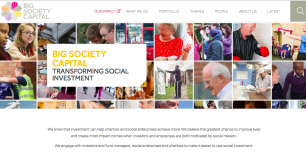How to get social investment back on track: A checklist for foundations
Social investors are too busy looking to the rooftops, instead of spending time helping investees build strong and solid foundations. And they’re still attempting to squeeze investment opportunities to fit pre-defined debt products that meet their own requirements before those of the investee. This leaves a clear role for impact-first foundations moving into this space, write Niamh Goggin and Sarah Forster – if they can apply some thoughtful, demand-led principles in their approach.
“Social investors are too busy running to the top floor to get the impact coming out of the chimney – when the foundations haven’t been built to provide strength and stability to the organisation.”
These were the words of a social investor we interviewed earlier this year as part of a research project for a well-known charitable trust. For us, they highlight the critical issue of whether social investment is actually filling the void between increasingly scarce grants and investments seeking full commercial returns.
Social investors are too busy running to the top floor to get the impact coming out of the chimney – when the foundations haven’t been built to provide strength and stability
Indeed, the sentiments of this interviewee echo the views of many of those seeking and providing social investment across the UK today – that not enough is being done to build the organisational capacity and sustainability of social enterprises. Until these issues are prioritised by social investors, their investment strategies risk being perpetually out of sync with the real-world needs of investees.
During our research – which aimed to help our client explore how to integrate social investment into its overall anti-poverty strategy – we spoke to investee social enterprises and charities, venture philanthropists, specialist social investors and impact investors operating in mainstream financial markets across the UK. We also reviewed social investment approaches from the US, EU and developing countries.
|
Social investing or impact investing? According to the Global Impact Investing Network (GIIN), impact investing refers to any form of investment ‘made with the intention to generate positive, measurable social and environmental impact, alongside financial returns’. It brings a third dimension – impact – to traditional financial investment considerations of risk and return. In the UK, the market has so far largely focused on ‘social investment’: the provision of repayable finance to charities, social enterprises and community organisations to develop activities that achieve social outcomes, generate earned income and build more sustainable business models. Although the UK market is developing rapidly and impact investing approaches and products are becoming a new segment of mainstream finance, our focus in this research was on the traditional social investment market. |
We received strong feedback from both investors and investees that if the primary goal is delivering impact, then social investment, as it currently stands, is not fit for purpose. One experienced investor summed up the views of many of those we spoke to, saying social investment today:
- “is extremely risk averse and not comfortable in supporting innovation with long-term transformational potential”
- “is focused almost entirely on loans rather than equity”
- “is focused on short-term financial returns”
- “is not really filling the gap that exists between grants (not seeking any returns) and full commercial returns”
This analysis echoes what we heard throughout the research. Social investors are attempting to squeeze investment opportunities to fit pre-defined debt products that meet the requirements of the investor more than the investee. Several interviewees also highlighted the fact many social investors do not have experience running small businesses – they come from charity or big finance backgrounds. Too much emphasis is frequently put on access to finance, and not enough on helping social enterprises develop the skills, market networks and capacity they need to build a successful business.
An impact-driven approach
But from a foundation’s perspective, an impact-driven approach could include social investment sitting within an overall strategy designed to support social change. Indeed, it could also complement research, grant-making, partnerships, advocacy and other tools in the philanthropic toolbox. Our research suggests this requires:
- more focus on understanding the nature of the problem to be solved and being prepared to invest in developing and testing social enterprise models that can deliver positive impact (through a ‘learning lab’ approach);
- facilitating partnerships across the social, public and private sectors that can spark new approaches to tackling social problems;
- a clear investment policy and process, alongside appropriate products, that focus on outcomes as well as financial risk and return
- an approach which is demand-led, not product-led, ensuring the financing structure is well-suited to the stage of growth and financial position of the investee and with a willingness to be flexible and provide patient, risk capital;
- a focus on organisational capability-building from the start to help ensure investees have the skills, networks and business support they need to develop a sustainable business model;
- a bottom-up impact measurement and management approach, which considers beneficiary impact, enterprise impact and systemic/market-shifting impact; and
- use of ‘every tool in the toolbox’, including convening power based on trust, and thought leadership through research.
An impact-driven investment strategy should be designed around the real-world need
An impact-driven investment strategy should be designed around the real-world need. It would identify potential investees on the basis of their potential to be a gamechanger or to create systemic change, and then structure the social investment product to provide investment terms and conditions best suited to support the delivery of outcomes. Isn’t that what we mean by “form and function are one” (in other words, there should be harmony and integration between form and function)?
We’re confident this is a space where charitable foundations are particularly well-suited to play a leadership role backing social investment approaches which put impact creation first, take risk and have a long-term perspective to delivering sustainable financial returns.
Now is the time for those charitable trusts to use their collaborative strength and collective assets to make a crucial, strategic shift in social investing in the UK.
Thanks for reading Pioneers Post. As somebody working in the impact economy, you'll know that producing quality work doesn't come free. We rely on paid subscriptions and partnerships to sustain our purpose-led journalism – so if you think it's worth having an independent, specialist media platform to share your news, insight and debate across the globe, please consider subscribing. You'll also be buying social: Pioneers Post is a social enterprise itself, reinvesting all profits to help you do good business, better.
Header photo by Kinga Longa on Pexels.



